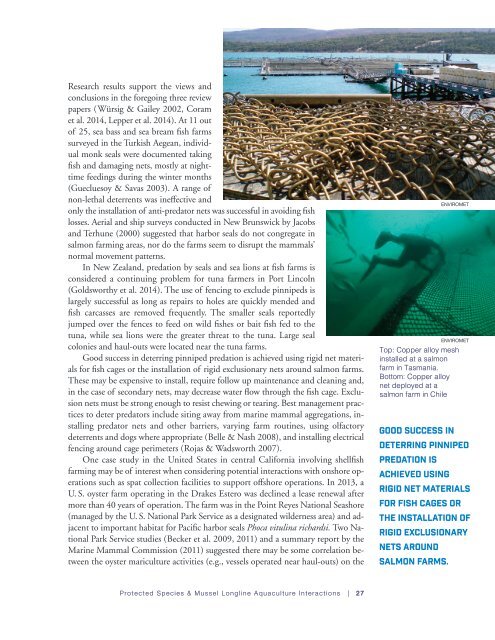Protected Species and Marine Aquaculture Interactions
x9Jh2
x9Jh2
Create successful ePaper yourself
Turn your PDF publications into a flip-book with our unique Google optimized e-Paper software.
Research results support the views <strong>and</strong><br />
conclusions in the foregoing three review<br />
papers (Würsig & Gailey 2002, Coram<br />
et al. 2014, Lepper et al. 2014). At 11 out<br />
of 25, sea bass <strong>and</strong> sea bream fish farms<br />
surveyed in the Turkish Aegean, individual<br />
monk seals were documented taking<br />
fish <strong>and</strong> damaging nets, mostly at nighttime<br />
feedings during the winter months<br />
(Guecluesoy & Savas 2003). A range of<br />
non-lethal deterrents was ineffective <strong>and</strong><br />
only the installation of anti-predator nets was successful in avoiding fish<br />
losses. Aerial <strong>and</strong> ship surveys conducted in New Brunswick by Jacobs<br />
<strong>and</strong> Terhune (2000) suggested that harbor seals do not congregate in<br />
salmon farming areas, nor do the farms seem to disrupt the mammals’<br />
normal movement patterns.<br />
In New Zeal<strong>and</strong>, predation by seals <strong>and</strong> sea lions at fish farms is<br />
considered a continuing problem for tuna farmers in Port Lincoln<br />
(Goldsworthy et al. 2014). The use of fencing to exclude pinnipeds is<br />
largely successful as long as repairs to holes are quickly mended <strong>and</strong><br />
fish carcasses are removed frequently. The smaller seals reportedly<br />
jumped over the fences to feed on wild fishes or bait fish fed to the<br />
tuna, while sea lions were the greater threat to the tuna. Large seal<br />
colonies <strong>and</strong> haul-outs were located near the tuna farms.<br />
Good success in deterring pinniped predation is achieved using rigid net materials<br />
for fish cages or the installation of rigid exclusionary nets around salmon farms.<br />
These may be expensive to install, require follow up maintenance <strong>and</strong> cleaning <strong>and</strong>,<br />
in the case of secondary nets, may decrease water flow through the fish cage. Exclusion<br />
nets must be strong enough to resist chewing or tearing. Best management practices<br />
to deter predators include siting away from marine mammal aggregations, installing<br />
predator nets <strong>and</strong> other barriers, varying farm routines, using olfactory<br />
deterrents <strong>and</strong> dogs where appropriate (Belle & Nash 2008), <strong>and</strong> installing electrical<br />
fencing around cage perimeters (Rojas & Wadsworth 2007).<br />
One case study in the United States in central California involving shellfish<br />
farming may be of interest when considering potential interactions with onshore operations<br />
such as spat collection facilities to support offshore operations. In 2013, a<br />
U. S. oyster farm operating in the Drakes Estero was declined a lease renewal after<br />
more than 40 years of operation. The farm was in the Point Reyes National Seashore<br />
(managed by the U. S. National Park Service as a designated wilderness area) <strong>and</strong> adjacent<br />
to important habitat for Pacific harbor seals Phoca vitulina richardsi. Two National<br />
Park Service studies (Becker et al. 2009, 2011) <strong>and</strong> a summary report by the<br />
<strong>Marine</strong> Mammal Commission (2011) suggested there may be some correlation between<br />
the oyster mariculture activities (e.g., vessels operated near haul-outs) on the<br />
ENvIROMET<br />
ENvIROMET<br />
Top: Copper alloy mesh<br />
installed at a salmon<br />
farm in Tasmania.<br />
Bottom: Copper alloy<br />
net deployed at a<br />
salmon farm in Chile<br />
Good success in<br />
deterring pinniped<br />
predation is<br />
achieved using<br />
rigid net materials<br />
for FIsh cages or<br />
the installation of<br />
rigid exclusionary<br />
nets around<br />
salmon farms.<br />
<strong>Protected</strong> <strong>Species</strong> & Mussel longline aquaculture interactions | 27


